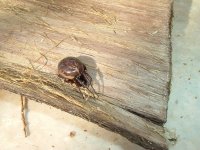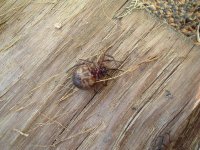Definately a Steatoda. 99% It's Steatoda nobilis. You're in the right part of the UK for it. If the abdomen is much bigger than 5mm then 100% sure. Careful with these, they can give a really unpleasent bite, not dangerous (unless you happen to be hypersensitive) but you'll feel it. The Steatoida are a sister clade to the Lactrodectus (widow spiders) and carry very similar venom. A good envenomation by a big S. nobilis can present very similar symptoms to a widow bite, only far less extensive. It is most likely that this species came across from mediterranean europe on ships but *may* have existed here naturally. Either way, it is only in the last 10-20 yrs that they have started to spread away from ports. Cracking find, easily one of our most interesting little critters, and don't worry about the birds, it's just lunch to them!
Lee.






